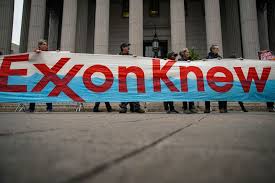New York. October 25. New York Supreme Court. Antigovernment News Bureau. The downsized “Exxon knew” trial currently occurring in New York Supreme Court in lower Manhattan provides a look into several larger-scale litigation choices by ExxonMobil attorneys. Exxon is being sued by the State of New York for accounting discrepancies in the company’s reports and documents.
In essence, the claim against ExxonMobil is that the company published different projections of the burden of future carbon regulations at different times in different documents. In some cases, these costs-per-ton-of-carbon-by-2040 projections are represented in colors on Exxon maps. The New York Attorney General alleges that these different numbers constitute securities fraud. Exxon counters by stating the numbers represent different things for different purposes; sometimes they represent demand projections; sometimes they represent cost projections.
It is almost certain that no investor in the world made any investment decision based on the color coding of maps in Exxon’s climate change reports. Indeed, the State of New York doesn’t appear to be able to produce any witness who claims to have bought, held, or sold Exxon stock based on the color-coded maps. This case may be one of the weakest ever brought before the courts of New York (and that’s saying something).
In fact, it is well known that the State of New York originally sought to develop a case along the lines of the “Merchants of Doubt” theory that Exxon had secretly funded “climate denial” movements to delay and thwart the progress of consensus science and thereby to reap billions in fraudulent profits. A 3-year investigation involving 4 million pages of documents apparently killed that notion. (*Note that just days ago the Massachusetts Attorney General’s office announced that it was launching another “Exxon knew”-type investigation; stay tuned!)
A significant question is why Exxon’s lawyers opted to waive their right to trial by jury. The case is being heard by a single elderly judge, Barry Ostrager. It may be that ExxonMobil views New York City as hostile terrain and concluded that any jury pool of New Yorkers might be biased against the corporation. But polls show that the climate crusade is mostly a movement of wealthy elites in academia and government, and that the religion dies whenever and wherever it is subjected to a popular vote or an open forum.
Fully a third of Americans report thinking that manmade global warming may be a total hoax. The comment threads that follow online climate change news stories are often filled with skeptical comments which often refute the articles above. Some newspapers have discontinued commenting altogether rather than face embarrassment by skeptics. The LA Times even bans climate skeptical letters to the editor altogether.
Wherever the theory of catastrophic climate change has been subjected to a debate, it has fared poorly. Consequently most promoters of the climate doomsday theory avoid any and all debate in open forums.
Climate skeptic sites such as Wattsupwiththat.com receive the most traffic of any climate-related websites, and have been known to win “best blog” and “best science blog” awards in popular votes. After Wattsupwiththat.com was awarded “best science blog” for 5 years between 2008 and 2013, the Guardian Environment Blog discontinued the science category in 2014.
All of this suggests that a trial by jury may prove more favorable to fossil fuel concerns than a bench trial. In any case, the State of New York failed to land many hard blows against Exxon during the first week.
Trial continues Monday. Stay tuned!


